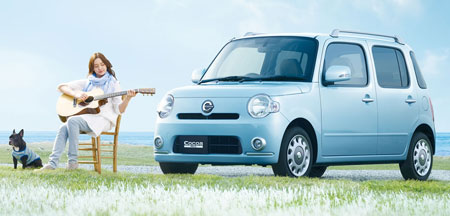
Daihatsu has launched yet another body variation of the Mira in Japan, this time called the Mira Cocoa, joining the Mira and the Mira Custom in the K-car range.
In Daihatsu’s own words, the use of the name Cocoa was chosen because the car intends to give the driver and passengers that comfortable and relaxed feeling of drinking a hot cup of cocoa on a cold day.
The Mira Cocoa measures 1,530mm in height, 1,930mm long and 1,345mm wide. Only one engine option is available in Japan – the 660cc KF-VE with DVVT variable valve timing, producing 58 PS at 7,200rpm and 65Nm of torque at 4,000rpm. There are two different transmissions available – a 4-speed auto or a CVT transmission, with the latter being more fuel efficient.
For the 2WD car, the CVT can provide up to 23.5 km per litre on the Japan 10-15 test cycle while the 4-speeder can only do 19.4km per litre. 4WD versions can do 20km and 18.6km per litre respectively for the CVT and 4-speed cars.
Daihatsu is shouting about the funky new rear view mirror that they’re using in the Mira Cocoa, claiming its the first of its kind installed in a vehicle in Japan. It integrates a back view monitor into the rear view mirror, which is also equipped with an auto anti-glare function. Now I wonder why there’s no mention of aerodynamics values…
Source
[zenphotopress number=99 album=445]
Looking to sell your car? Sell it with Carro.


AI-generated Summary ✨
Comments generally express excitement and positive anticipation for the new Perodua model, with many hoping it will replace the Kenari and praising its cute, retro, and boxy design, reminiscent of the Nissan Cube and Daihatsu Mira Cocoa. Several users mention the vehicle's practicality, fuel efficiency, and city suitability. However, there are also notable criticisms, highlighting concerns about the car's outdated look, small size, and potential quality issues like power window problems. Some comments suggest skepticism about bringing this model into Malaysia, referencing past failures like the Kenari, while others humorously compare it to cars like the Mini Cooper or Mitsubishi models. Overall, sentiment is mixed but leans toward curiosity and hopefulness about the car’s potential success in the Malaysian market.